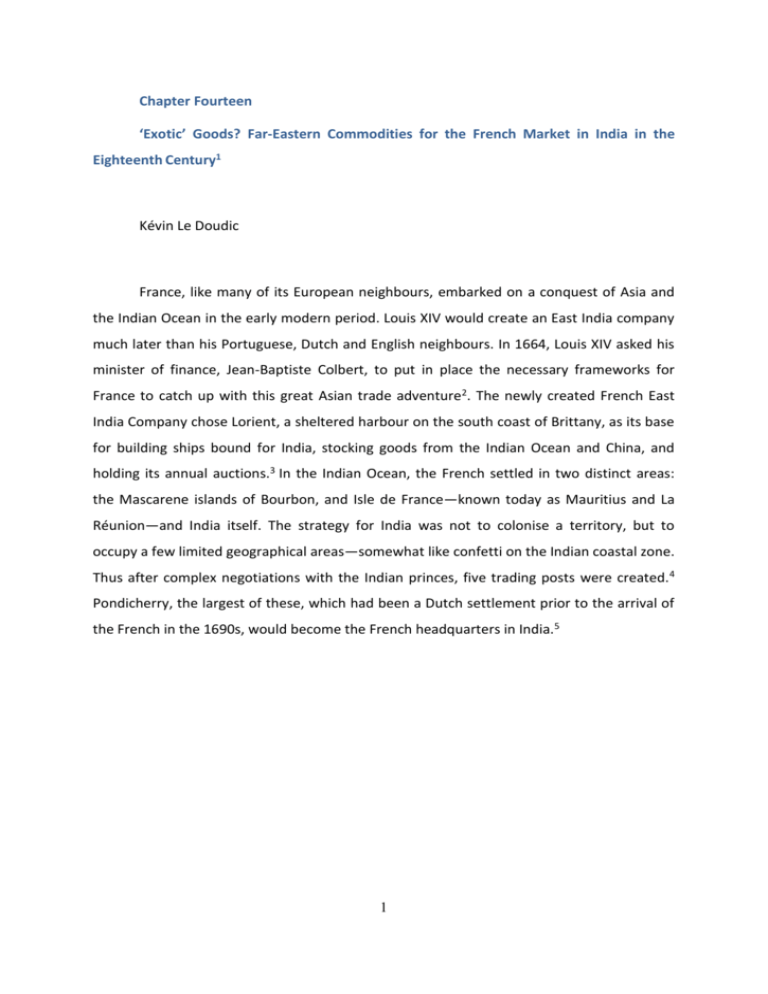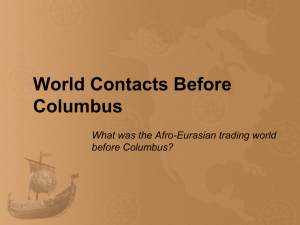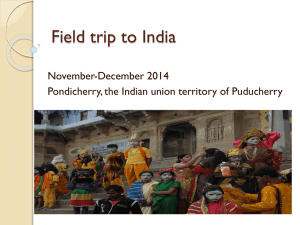“Exotic” Goods? Far-Eastern Commodities for the French Market in
advertisement

Chapter Fourteen ‘Exotic’ Goods? Far-Eastern Commodities for the French Market in India in the Eighteenth Century1 Kévin Le Doudic France, like many of its European neighbours, embarked on a conquest of Asia and the Indian Ocean in the early modern period. Louis XIV would create an East India company much later than his Portuguese, Dutch and English neighbours. In 1664, Louis XIV asked his minister of finance, Jean-Baptiste Colbert, to put in place the necessary frameworks for France to catch up with this great Asian trade adventure2. The newly created French East India Company chose Lorient, a sheltered harbour on the south coast of Brittany, as its base for building ships bound for India, stocking goods from the Indian Ocean and China, and holding its annual auctions.3 In the Indian Ocean, the French settled in two distinct areas: the Mascarene islands of Bourbon, and Isle de France—known today as Mauritius and La Réunion—and India itself. The strategy for India was not to colonise a territory, but to occupy a few limited geographical areas—somewhat like confetti on the Indian coastal zone. Thus after complex negotiations with the Indian princes, five trading posts were created.4 Pondicherry, the largest of these, which had been a Dutch settlement prior to the arrival of the French in the 1690s, would become the French headquarters in India.5 1 Figure 13.1:Map of the Coromandel Coast The unusual geographical and cultural position of such a western trading post in India led to the development of a uniquely hybrid consumer culture. That culture will be the subject of this chapter. The particular focus of the chapter will be on products from the Far East. That is to say, products from the region stretching from the eastern part of India to Japan, since such goods were subject to a very specific form of consumption. Some of them were so widespread as to become commonplace, and completely blended into the daily habits of the French. Others, however, continued to be seen as exceptional and exotic, reflecting a fondness for Asia in certain categories of the population. To appreciate the various roles these Eastern goods played in a French trading post located in India, it is first necessary to establish how Pondicherry was supplied, and what the far-eastern supply areas in question were. Since private trade was the most important means of provision of far-eastern goods, a closer look at the functioning of this trade, at the 2 personnel involved in such enterprises, and at the distribution networks is required. However, the cultural value of such goods, the place that they held in the everyday environment of French people is best understood through the conceptual lens of the exotic. Thus, analysing a particular style—the ‘East India Company Style’—reveals that exotic, fareastern and European commodities were perfectly complementary in French homes in Pondicherry, but that they had very different connotations. World-wide supplying Studies of material culture in Europe in the Eighteenth Century often run up against the difficulty of identifying where the acquired goods were coming from. This is particularly the case when the goods in question originate from other regions, countries or even continents. We are confronted with a similar problem when it comes to research on the ownership of European goods in India. In this case, the foreign objects came from Europe or the Far East, while the households under study are French. To understand the consumption regime of Pondicherry residents, it is necessary to take into account the totality of available products and provisioning networks, and then to differentiate further between, on the one hand, ‘chosen consumption’—where there were sufficiently wide-ranging and varied alternatives on offer—and, on the other hand, ‘forced consumption’, when shortages would limit any possibility of preferential choice. Pondicherry or the French "island" of the Coromandel Coast Several factors gave the trading post a sense of insularity, the first and foremost being its location on the Coromandel Coast, in the South of India. Everything that came in and out of Pondicherry did so by sea, whether the products in question came from Europe, the Mascarene Islands, the Far East, or other trading posts in India. The sea made it possible for Pondicherry to be connected to Europe and the wider Asian area. The cargo of the ships that left Europe for India was made up of two categories of products: metals to be transformed for currency use, and consumer goods. Ranking first among those goods were 3 foodstuffs, most of which were spirits. Eau de vie was much consumed in India by all demographic categories. Wine was reserved for the well-off, especially when it came to French PDO wines such as Bordeaux, Champagne, Burgundy, and so on, but the same still held for Madeira or for Italian wine from Calabria. For transport and storage reasons, foodstuffs were mostly limited to these spirits. Only Dutch cheese was inventoried a few times. There were a variety of other goods imported from Europe: textiles (including fine materials such as lace); tin or silver plates; and more rarely Sèvres or Saxony porcelain. The cargo was supplemented with small furniture items, art objects, weapons, herbal remedies, books, jewellery, and so on. India mainly provided common consumer goods, ranking first among which were foodstuffs. Pondicherry was surrounded with rice plantations which served as the staple that helped meet the needs of the Indian and European populations of the city. On top of this, one can add poultry, game, and cattle, which were another part of daily meals. Fruit also played an important part, because the climate made their cultivation easy, and their variety kept people from getting fed up with them. What is more, most of them could be grown directly in the gardens of Pondicherry homes, which amounted to substantial savings. But India also provided a large amount of cloth and painted fabric for clothing and interior furnishing. Indian and French tailors did the rest in order to allow Westerners to dress like Europeans, while being able to use the lightness of Indian textiles which were much more suited to the South Indian climate. Supply areas of the Far East However, none of this was sufficient. Pondicherry appealed to the far-eastern market to fill in the gaps of both Indian production and European imports. In order to do this, the trading post could rely on a so-called ‘country trade’ network, Asia's internal trade, to find sources of supply for consumer goods and building materials. Pondicherry was furnished by three main areas. The closest one consisted of the Indonesian archipelago, Manila, Aceh, and Batavia. To these Pegu in Burma and Mergui in Siam can be added, today known as Bago and Myeik in Myanmar. The second area was China, a first class source of supply, not only in terms of the quantities of imported goods, but also in terms of their 4 quality. The third and final area was Japan, which was characterized by the very high quality of the products supplied. Although the existing facilities and networks made it possible to trade with the Far East, the political dimension played an important part in shaping and limiting this trade. The presence of European nations was not tolerated and permitted in the same way in all parts of the Indian Ocean and East Asia. The example of Japan is characteristic of this. In 1639 the Portuguese, who were allowed to engage in trade there, were expelled, thereby leaving the privilege of trading with the Land of the Rising Sun solely to the Dutch.6 Such trading monopolies did not mean, however, that it was impossible for any given nation to obtain products from such countries. They were simply forced to resort to intermediaries. Figure 13.2: Supply Areas of the Far East for the French Market in Pondicherry Private trade: a widespread practice throughout society Before looking at the use that was made of goods coming from the Far East, it is essential to understand how they came to Pondicherry, and how Europeans had access to them. 5 Private traders and individual trading Trading was central to the lives of Pondicherrians, whether French, English, Armenian, or of course Indian. On this issue, the notarial archives leave no room for doubt. While it is logical to find inventoried goods from merchants, traders, and ship owners, it is much more surprising to note that many other individuals were also engaged in such practice. It is indeed essential to differentiate between these two types of trade: ‘private trade’ conducted by professionals such as ship owners, traders, and so on; and ‘individual trade’ which was conducted by individuals whose occupation was not related to trade at all.7 The notary deeds provide very precise data on the composition of wealth, and thus allow for the easy identification of commercial-purpose goods. That is to say, goods which were destined for resale, and which were in the meantime stored in private homes. It appears that people from all occupational categories represented in this city were involved in trading, whether they were military personnel, administrative staff of the East India Company, crew members, servants, craftsmen, or similar. But there are, of course, variations across ranks or occupational levels. Remarkable examples abound. To cite only one particularly striking case, let us take the case of a clergyman named Father de Walle.8 In his case, 90 per cent of the property inventoried after his death was made up of commercial-purpose goods. This consisted of five bales containing seven hundred and twenty pieces of cloth of various kinds—which could have been used, ultimately, to make more than seven thousand handkerchiefs. We are very far from the sort of activity that might be expected of a clergyman in eighteenth-century India. Distribution channels for Far East products The issue of trade networks within the trading post itself is an important one. Where did the ‘merchants’ whose occupation was not trading get their supplies from? Their unofficial activities replicated well-developed existing commercial networks. The East India Company did delegate country trading to private individuals. The very substantial benefits that those individuals drew from such business were indeed well known, and sparked many 6 a trading vocation. Although professional country traders are well known, much less well known is the role played by individuals. Yet, these individuals actively participated in the fitting out of ships to the Far East. They could do so in two ways: either by directly investing money to buy goods that were loaded onto ships to be exchanged when they reached destination, or by lending money, including by means of bottomry loans, to merchants in order to draw a benefit at a later stage. The products were then circulated in Pondicherry. Unfortunately, we have little evidence that could provide reliable information about such resale practices. Records show, however, that some French people owned shops in the trading post that were kept by Indians. Such is the case for Charles de Flacourt, an individual merchant who owned sixtyfive shops in the St. Lawrence bazaar in Pondicherry.9 In this way, the products were made available to the greatest possible number of people, including the sailors returning to Europe who used them to compose their precious ‘pacotille’.10 7 Figure 13.3: Distribution Channels for Far East Products in Pondicherry Products from the Far East: from raw material to work of art Having established where the merchandise and consumer goods were coming from, through which networks they made their way to the trading posts of India, and by whom they were traded, we can finally think about the places such far-eastern goods held in the lives of the French, and about the cultural value attached to them. The notion of ‘exoticism’ is a key element here, and it is essential to reconsider its perception in the context of the Pondicherry trading post in the Eighteenth Century. Although exoticism has been widely studied in the European context, especially through the study of consumption, for the same time period as the one studied in this chapter, the perspective must be adjusted when 8 studying a French population in India. ‘Exoticism’ will be defined here as the desire for a certain distant ‘other’ which, as an agent of displacement, and due to its near-inaccessibility, fascinates and compels. When they arrived in India in the second half of the Seventeenth Century, the French were probably impressed and bewildered by their new daily environment. But would that still have been the case after they had spent several months there or, better yet, when they were descendants of several generations of families who had settled in the Indian Ocean? As this chapter will show, depending on the products, the ‘exotic’ dimension fluctuated. Raw materials and common consumer goods There was not a wide range of raw materials coming from the Far East. Their first and foremost purpose was to make up for a shortage, or at least for the bad quality, of such materials in India. This is particularly the case for copper, which came from China or Japan, or for the renowned Mergui wood from Siam and for Pegu teak from Burma. Some of these woods were highly prized by cabinetmakers and joiners, who used them to make furniture. They were mainly used for building houses, but also used for shipbuilding. Teak doors and windows were not uncommon in Pondicherry, since teak wood possesses a combination of beautiful appearance with a high resistance to the hot and humid climate of monsoon period. 11 Precious materials were also imported: ivory, gold, and tombak from the Philippines; sapphires and crystals from Ceylon. For packaging and shipping time reasons, the only foodstuffs that were brought in from the Far East were limited to arrak, a strong liquor from Batavia, wine from Japan, and rice from Burma. China mainly supplied tea, sugar and the odd jar of jam. More unexpectedly, Achem, today known as Banda Aceh in the north of the island of Sumatra, was one of the main places supplying horses: several boats were sent out to import these animals to Pondicherry, where they were highly valued for their endurance at work. 12 Resorting to China and Japan to get furniture and clothing But it is inside the homes of French people in the trading post that the Far East was most represented. Whole sets of manufactured objects, coming mainly from China and 9 Japan, were making their way to all the rooms in the house. These were objects commonly used in everyday life such as bowls, ewers, spittoons, or boxes of all sorts—for soap, wigs, tea, tobacco, and so on. On top of this, one would find porcelain tableware: plates, bowls, kettles, teapots, coffee pots, dishes, cups, saucers and mugs. Their quality varied from common china, often with blue decorations, to armorial porcelain reserved for families with their own coat of arms. Then came a series of small utilitarian objects: fans, writing cases, canes, ‘cabarets’, or spirit cellars with their flasks. Medium-size furniture supplemented the lot: folding screens made of wood or canvas; and tables, chairs, and armchairs, which were often made of lacquered wood. Textiles from China also played an important part in interior furnishing, mainly to stuff seats and armchairs, but also to cover the floors with Chinese rugs. But it was in clothing that most of the fabric was used. The French were very keen to preserve European dressing styles. Clothes therefore followed western standards but were made with silk, satin, velvet, Nankin, Pekin cloth, and so on. Figure 13.4: Fan with Pheasants, China 1670-168013 A choice place among collectors 10 China and Japan also embodied the quest for beauty and rarity. The French indeed made use of objects from the Far East to show their taste for art and also for unusual objects, which were referred to as ‘curiosités’ in Europe. It was a real luxury trade that started developing in the 1740s and 1750s, with the emergence, among the well-off, of actual collections of such art objects. This is how vases and decorative urns made of Japanese Imari porcelain entered the sitting rooms of French homes. Chinese statuettes, most often made of varnished clay and representing female figures or animals, were exhibited, as were stone or bronze statuettes which could often take the form of a Chinese lion. The odd Chinese porcelain figurine could also be found, though more rarely, since buyers back in Europe were very keen on them at the time. Walls were decorated with paintings and engravings, framed in wood that was gilded or painted red and depicting Chinese scenes. Finally, some rare items reflected the interest that the French took in Asian know-how: inventories show two allusions to ‘moving figures’. These were in fact automata from China: articulated dolls equipped with complex mechanisms and made from precious materials. These were very rare items in India at that time which were also much sought after in Europe. This interest in civilizations and broadening of mental horizons is a well-known phenomenon of the time period. It is therefore logical that we find numerous indications of these trends in Pondicherry. However, in India, the Europeans were in direct contact with the civilizations that were so fashionable back in Europe. The Enlightenment interest in the exotic was therefore doubled by the necessity of knowing their local interlocutor. To do this, numerous works on these civilizations became common in the libraries of the French in Pondicherry. These would include The History of Persia and Asia, The History of the Big Island of Madagascar, The History of China, or even The History of Mohammed. At the same time, these Asian items stand stark contrast to the way in which the French tried constantly to surround themselves with references to Europe throughout the entire Eighteenth Century—be this through architectural styles, through western-like shapes for furniture, or through the contents of their wardrobes. 11 Figure 13.5: Chinese Madarin (automata), China 1790-180014 The ‘East India Company Style’: The complementarity of Asia and Europe Within a house, the space of social representation was undoubtedly the sitting room, where all the guests were welcomed.15 During the Eighteenth Century, a great deal of attention was paid to the furnishing of this room. This space can be studied from an economic point of view. That is to say, by measuring the financial effort that was put into its furnishing. However, it seems more interesting and revealing to concentrate on the qualitative aspect here. A very clear evolution can be identified during the Eighteenth Century in the style of objects used to create a sitting room. At the beginning of the French 12 settlement in Pondicherry, the goal was to use local elements as furnishings. The distinction between the social categories was the number of pieces of interior furniture dedicated to comfort. Little by little, as the trading activity developed in Pondicherry, it was no longer the number of pieces of furniture but their quality that made the difference. The goal became to obtain that which was the rarest. Thus, in a trading post located several months of sea travel from Europe, the most difficult way to furnish was in the French style. It is very notable that, in the first quarter of the Eighteenth Century, some interiors of the higher social categories were only decorated in a French style to set them apart from inferior groups who could not obtain such rare furniture. In the second half of the Eighteenth Century, the French furnished in a European style, which at that time was visible in the interiors of the homes of most categories of the population. What would finally distinguish between higher classes and lower classes would be the introduction of artefacts and objects d’art of Asian origin. Indeed, it can be noted that a desire to collect would go hand in hand with the wealthiest individuals’ interest and infatuation with Asian civilizations. This need to set themselves apart from other social groups is of course not something original to Pondicherry, and can be found in every western society. However, if it was relatively easy to import small decorative objects from Europe—such as mirrors, paintings and engravings sold by the Company—or daily consumer goods—such as knives, snuffboxes, and playing cards, sold by the seafarers arriving from France—it was much more complicated, if not impossible, for even the wealthiest employees and merchants of Pondicherry to acquire larger items such as furniture coming from Europe. To solve this storage and transport issue they resorted to the ‘East India Company style’, which can be characterised in two ways. There is first of all the artefact itself: objects that can still be found in many museum collections, and which are made of Asian materials, woods, fabrics, but crafted in a European style. However, this style can also be seen, more broadly, through the very composition of the house itself. This can be shown by analysing the proportions of Asian and European artefacts that are found within it. Such an approach gives information on the interior design and layout sought by the inhabitants, which met their own personal desires, as well as external constraints. 13 Interior decoration patterns evolved over time. At the beginning of French presence in India, in the last third of the Seventeenth Century, Indian goods made up for the large majority of items present. This was a given, since the French had only just started moving to Pondicherry. There were not yet many European artefacts in circulation, so they had to use what was available on site. Over time, the portion of Asian artefacts continuously gave way to European ones, each attaining equivalent portions. From the 1740s and 50s onwards, items that we can class as European, due either to their actual provenance or to their design, become more and more important and increasingly dominated domestic interiors. Asia still had its place here, too, but no longer through the great quantity, but through the great quality of its goods, which included works of art, fine textiles, or indeed ‘curiosités’. Figure 13.6: Rosewood Console Table in Louis XV Style16 The ‘East-India Company style’ quickly spread through Pondicherry because it was important for the French to demonstrate their taste for beautiful artefacts. Owning rare pieces of furniture was a way of distinguishing oneself from lower social classes. The desire for innovation is a constant for the elites, which is then imitated by lower social classes. 14 Interior furnishing is thus one way of integrating into a social class and of demonstrating one’s belonging to it. It is difficult to establish precisely the craftsmanship of this style of furniture, as archival sources are rare. I have however been able to identify one master carpenter, a Jean Roze who boarded in Lorient in 1727 on Le Mercure, an East India Company ship which was Pondicherry bound.17 Luckily, he died. Luckily, because his death furnished us with his probate inventory which confirmed that he was in fact a joiner, and not a carpenter.18 He practiced his profession from his home, as can be seen from the large variety of raw wood species, as well as a wide variety of furniture listed in his probate inventory, that was exceptional for someone of that social class. There were indeed French craftsmen who worked in Pondicherry. However, a piece of furniture preserved in Lorient’s Museum of the East India Company has led us to believe that Indian craftsmen created copies of French pieces. The item in question is a settee of the purest Louis XV or Régence Style made in Pondicherry during the mid-Eighteenth Century. 19 Taking a closer look at its armrests, one can make out three wooden half-spheres, which are in fact a rather poor interpretation by the craftsmen who used a model, probably a printed one, to make the piece of furniture. In the original model they were bullen nails, used to hold the fabric in place. However, since the Pondicherrian settee was made of canework, bullen nails were not needed. We can conclude that the piece was completely copied from a model, probably by Indian craftsmen.20 The material object can be regarded as the realisation of human will, of a need, or of an interest specific to an individual or a society. Studying it across the whole of the Eighteenth Century makes it possible to follow its stylistic evolution, and the origin of the materials used. Far eastern merchandise was ubiquitous in the everyday life of French people in Pondicherry in the Eighteenth Century, but various types of merchandise played different roles. On the one hand, some merchandise was making up for the lack of building material or consumer goods. On the other hand, some types of merchandise were favoured among the well-off, who included the Chinese and Japanese productions in their art object 15 collections. The analysis of the interiors of the French in Pondicherry and their material culture should be based on the artefact itself; all whilst taking into account the globality of the elements making up the material culture in question. The quantitative and qualitative analyses should must be conducted in conjunction in order to obtain as faithful a vision as possible to the daily-life environment in the Indian trading post: on a material level of course, but on a social one as well. As in every group, the French society of Pondicherry needed to structure itself to function as efficiently as possible for trade, and also for social balance. This was all the more true for the trading post societies that evolved far from the reference model which was their country of origin. The French would therefore resort to more or less conscious mechanisms to guarantee balance in social relations. For these reasons and in order to be comprehensive, a study of material culture must take into account other social parameters: the place of residence as indicator of social position; the marriage and generational position as a factor of integration in the network; internal structure as indicator of belonging to one’s group; and the activities of adherence to a social group. 21 In all of this, the concept of ‘exoticism’ is central because it is one of the deciding factors in the reasoning behind the acquisition of interior furnishings. The continuous goal of the French is innovation, in order to set themselves apart from other social classes and to reinforce their position as the elite. ‘Exoticism’ in Pondicherry was, therefore, defined by three factors: the moment the individual arrived in India, the length of residence, and the current trends in the trading post. At first, it was the Asian style that was exotic for the French. However, little by little during the course of the Eighteenth Century, as the French established their family lines, it was the European style that was sought as it was less common and more exotic. By midcentury, the trend began to stabilize. The French now had a lifestyle with common points of reference, which were shared by all of the inhabitants of Pondicherry. The Asian style was once again present in the home interiors, but the nature of the artefacts was different from those at the beginning of the century. 1 The research for this paper is mainly based on notary deeds conserved in the French Overseas Territories Archives in Aix-en-Provence, France (Archives Nationales d’Outre-Mer : ANOM, EFI, FT, 16 fonds Inde, série P : notariat de Pondichéry), and particularly on the probate inventories. The results in this study are based on data provided directly from the French notary deeds of Pondicherry and therefore are not exhaustive, particular when it comes to the list of goods from the different areas of the Far East. 2 Philippe Haudrère, La Compagnie française des Indes au XVIIIe siècle, (Paris: Les Indes Savantes, 2 vol., 2005 –seconde édition revue et corrigée); Donald C. Wellington, French East India Companies. A Historical account and Record of Trade, (Oxford: Hamilton Books, 2006); Marie Ménard-Jacob, Les jours et les hommes de la première Compagnie royale des Indes orientales(1664-1704), (PhD Thesis, Lorient: University of South-Brittany, 2012). 3 Claude Nières (ed.), Histoire de Lorient, (Toulouse: éditionsPrivat, 1989); Gérard Le Bouëdec, ‘La culture océan Indien dans le pays de Lorient au XVIIIe siècle’, in Jacques Weber (ed.), Les relations entre la France et l’Inde de 1673 à nosjours, (Paris: Les Indes Savantes, 2002), pp. 221-32; and Lorient Gateways to India, documentary for the European Commission, University of South-Brittany (France) and Jawaharlal Nehru University (India), Asia-Link Project: “The Europe-South Asian Maritime Heritage Project”, Scientific coordinator: Samuel Berthet, Scenario: Gérard Le Boudëdec, Kévin Le Doudic, Eugénie Margoline-Plot, Lorient, New Delhi, 2010. 4 Pondicherry, Karikal and Yanaon on the Coromandel Coast (South East / East), Mahé on the Malabar Coast (South West), and Chandernagor in Bengal (North East). 5 On the town of Pondichery see: Jean Deloche, Origins of the Urban Development of Pondicherry according to Seventeenth Century Dutch Plan, (Pondicherry: French Institute of Pondicherry, Publications Hors Serie 3, Royal Netherland Ambassy, New Delhi, Institut Français de Pondichéry, 2004); Jean Deloche, Le vieux Pondichéry (1673-1824) revisité d’après les plans anciens, (Pondicherry: Publications de l’Institut Français d’Indologie n°99, Institut Français de Pondichéry, École Française d’Extrême-Orient, 2005); Marguerite V. Labernadie, Le vieux Pondichéry, 1673-1815. Histoire d’une ville coloniale française (Pondicherry: Société d’Histoire de l’Inde Française, Imprimerie Moderne, 1936). 6 Philippe Haudrère, Les Compagnies des Indesorientales. Trois siècles de rencontre entre Orientaux et Occidentaux, (Paris: Éditions Desjonquères, 2006), p. 43. 7 On the issue of private trade: Peter James Marshall, ‘Private British Trade in the Indian Ocean before 1800’, in Ashin Das Gupta and Michael Naylor Pearson (eds), India and the Indian Ocean, 1500-1800 (New Delhi: Oxford University Press, 1987), pp. 276-300; Frédéric Mantienne, ‘Commerce occidental et sociétés asiatiques, XVIIe-XVIIIe siècle: les marchands européens au contact des pratiques commerciales et des sociétés locales’, in Martine Raibaud and François Souty (eds), Europe, Asie. Échanges, éthiques et marchés (XVIIe-XXIe siècles), (Paris: Les Indes Savantes, 2004), pp. 59-82. 8 Inventaire des biens de feu [abbé] Walle, ANOM, EFI, FT, fonds Inde, P083, 18 December 1758; Ouverture des balles de marchandises appartenant à feu [abbé] Walle, id., 17 October 1759. 9 Inventaire et vente des biens de feu Charles de Flacourt, ANOM, EFI, FT, fonds Inde, P017 f°227, 19 October 1720 10 Eugénie Margoline-Plot, ‘Seafarers’ private trade in Asia in the Eighteenth Century’, in Crossroads between Empires and Peripheries – Knowledge Transfer, Product Exchange and Human Movement in the Indian Ocean World, 21-23 June 2012, Ghent University, Belgium; Eugénie Margoline-Plot ‘Les circuits parallèles des toiles de l’océan Indien. Lorient au XVIIIe siècle’, Histoire Urbaine, 30 (2011), pp. 109-25. 11 Kévin Le Doudic, ‘Pondichéry 1774. L’Hôtel Lagrenée de Mézières’, in Gérard Le Bouëdec and Brigitte Nicolas (eds), Le Goût de l’Inde (Rennes: Presses Universitaires de France / Musée de la Compagnie des Indes de la Ville de Lorient, 2008), pp. 126-33. 12 Vente des chevaux appartenant à la Compagnie des Indes, ANOM, EFI, FT, fonds Inde, P023 f°515, 17 October 1722. 13 Courtesy of: G. Broudic / Musée de la Compagnie des Indes de la Ville de Lorient (France) Museum number : 201.4.1. / Ivory and bamboo, painted. 17 14 Courtesy of: G. Broudic / Musée de la Compagnie des Indes de la Ville de Lorient -Museum number: 2010.16.1 / H.: 62 cm / Ivory, hair, bamboo, laquered wood, cardboard, silk. Face and hands were crafted using carved and painted ivory. 15 Kévin Le Doudic, ‘The Sitting-Room: an instance of the Composite Culture of the French Residents of Pondicherry during the 18th century’, in Histories from the Sea, (New Delhi: Jawaharlal Nehru University & European Commission, December 2009), pp. 112-19. 16 By courtesy of: K. Le Doudic / Museum of Pondicherry (India) / Rosewood and marble. 17 Journal pour servir à l’enregistrement des actes d’engagement des ouvriers et autres pour différentes colonies du 14 novembre 1726 au 23 mars 1740, Service Historique de la Défense, Département Marine (SHDDM), Archives du Port de Lorient, 1P74 f°4, 19 septembre 1727; Pièces diverses relatives aux vaisseaux Le Mercure, SHDDM Lorient, 1P124-1, Rôle d’équipage du vaisseau Le Mercure, SHDDM Lorient, 1P167-95, 17 décembre 1727. 18 Inventaire des biens de la communauté entre feu Jean Roze dit Dufresne et Marie Anne Fournier, ANOM, EFI, FT, fonds Inde, P084, 1st December 1760. 19 Teak settee, mid-18th century, Musée de la Compagnie des Indes de la Ville de Lorient (France) – Museum Number : AF 5861. 20 On the issue of Indian Craftsmen see also: Amin Jaffer, Luxury Goods from India. The Art of the Indian Cabinet-Maker, (London: V&A Publications, 2002); Amin Jaffer, Furniture from British India and Ceylon. A Catalogue of the Collection in the Victoria and Albert Museum and the Peabody Essex Museum, (London: V&A Publications, 2001); Anna Jackson and Amin Jaffer, Encounters. The Meeting of Asia and Europe, 1500-1800, (London: V&A Publications, 2004). 21 Kévin Le Doudic, ‘Les Français à Pondichéry au XVIIIe siècle. Une société redessinée par sa culture matérielle’, Revue d’Histoire Moderne et Contemporaine (forthcoming). 18







